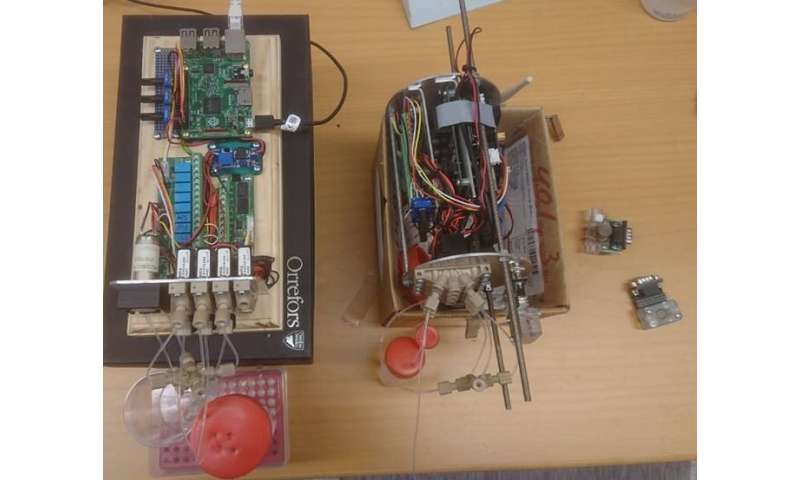by South Ural State University

Credit: pixabay
SUSU scientists, with their colleagues from Belgium and Egypt, have developed and tested a sensor for environmental monitoring. The device reveals insecticides in water. The research results have been published in Scientific Reports.
Accumulation of insecticides in the environment
Insecticides are important for agriculture. These are toxic substances that decompose in water and soil for a long time and have a negative effect on animals, birds and people when they accumulate in large quantities. Neonicotinoids dominate the market because of their selective toxicity. The most popular of these substances is imidacloprid.
Over nearly two decades, the presence of imidacloprid in the environment has increased, and monitoring it has become especially relevant. Current methods such as chromatography are effective. However, they require lengthy preparation of samples, a large amount of solvent and expensive equipment.
Researchers at South Ural State University, jointly with their foreign colleagues, proposed using the electrochemical method for this purpose. They were the first who introduced a capacitive sensor based on molecular imprinted polymers that can detect imidocloprid in water.
"Capacitive sensors belong to the category of impedametric sensors. To the best of our knowledge, this is the first molecularly imprinted, polymer-based capacitive sensor for detecting imidocloprid in water. Moreover, a two-step approach with a regeneration step between each analysis was first introduced to determine intermodulation distortions. This added the possibility of sequential use of each electrode 32 times," said Nataliia Beloglazova, senior researcher at the Nanotechnology Research and Education Center.
SUSU scientists, with their colleagues from Belgium and Egypt, have developed and tested a sensor for environmental monitoring. The device reveals insecticides in water. The research results have been published in Scientific Reports.
Accumulation of insecticides in the environment
Insecticides are important for agriculture. These are toxic substances that decompose in water and soil for a long time and have a negative effect on animals, birds and people when they accumulate in large quantities. Neonicotinoids dominate the market because of their selective toxicity. The most popular of these substances is imidacloprid.
Over nearly two decades, the presence of imidacloprid in the environment has increased, and monitoring it has become especially relevant. Current methods such as chromatography are effective. However, they require lengthy preparation of samples, a large amount of solvent and expensive equipment.
Researchers at South Ural State University, jointly with their foreign colleagues, proposed using the electrochemical method for this purpose. They were the first who introduced a capacitive sensor based on molecular imprinted polymers that can detect imidocloprid in water.
"Capacitive sensors belong to the category of impedametric sensors. To the best of our knowledge, this is the first molecularly imprinted, polymer-based capacitive sensor for detecting imidocloprid in water. Moreover, a two-step approach with a regeneration step between each analysis was first introduced to determine intermodulation distortions. This added the possibility of sequential use of each electrode 32 times," said Nataliia Beloglazova, senior researcher at the Nanotechnology Research and Education Center.

Credit: SUSU
The sensor was developed at SUSU, and their colleagues from the Ghent University, Belgium (Center of Excellence in Mycotoxicology and Public Health, Faculty of Pharmaceutical Sciences) also participated in its development.
Molecularly imprinted polymers were synthesized and then immobilized on an electrode surface. The two-step procedure prevented damage to the electrodes and ensured that no template molecules were present in the resulting particles. In addition, nonimprinted polymers were produced.
"The binding properties of the synthesized molecularly imprinted and nonimprinted polymers were tested using solution chromatography of tandem mass spectrometry. The proposed sensor showed a linear range of 5–100 µM with a detection limit of 4.61 µM," Nataliia Beloglazova said.
The sensor with a detection element was developed on the basis of another sensor proposed for testing by an international team. Testing was carried out using water samples from the Nile in Egypt. Therefore, research assistance was also provided by the staff of the Reference Materials Laboratory, National Institute of Standards (NIS), Giza, Egypt, and Beni-Suef University, Beni-Suef, Egypt.
Explore further Rapid detection of toxic compounds
More information: Suzan El-Akaad et al. Capacitive sensor based on molecularly imprinted polymers for detection of the insecticide imidacloprid in water, Scientific Reports (2020).
The sensor was developed at SUSU, and their colleagues from the Ghent University, Belgium (Center of Excellence in Mycotoxicology and Public Health, Faculty of Pharmaceutical Sciences) also participated in its development.
Molecularly imprinted polymers were synthesized and then immobilized on an electrode surface. The two-step procedure prevented damage to the electrodes and ensured that no template molecules were present in the resulting particles. In addition, nonimprinted polymers were produced.
"The binding properties of the synthesized molecularly imprinted and nonimprinted polymers were tested using solution chromatography of tandem mass spectrometry. The proposed sensor showed a linear range of 5–100 µM with a detection limit of 4.61 µM," Nataliia Beloglazova said.
The sensor with a detection element was developed on the basis of another sensor proposed for testing by an international team. Testing was carried out using water samples from the Nile in Egypt. Therefore, research assistance was also provided by the staff of the Reference Materials Laboratory, National Institute of Standards (NIS), Giza, Egypt, and Beni-Suef University, Beni-Suef, Egypt.
Explore further Rapid detection of toxic compounds
More information: Suzan El-Akaad et al. Capacitive sensor based on molecularly imprinted polymers for detection of the insecticide imidacloprid in water, Scientific Reports (2020).
Journal information: Scientific Reports
No comments:
Post a Comment